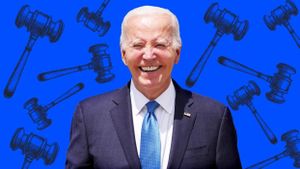Delhi and its surrounding National Capital Region (NCR) are engulfed by one of the worst air pollution crises to date, pushing government officials, residents, and health advocates to the edge. With the Air Quality Index (AQI) soaring above the alarming levels of 400, the capital has once again been forced to enforce severe measures under the Graded Response Action Plan (GRAP) aimed to combat air pollution.
The situation unraveled on November 15, when Delhi's air quality hit the 'severe' category for the third consecutive day, registering at 409, according to the Central Pollution Control Board (CPCB). With visibility drastically reduced, flights were delayed, and horrendous smog blanketed the city, shrouding iconic landmarks such as the Taj Mahal, which is located about 136 miles away. Residents were urged to stay indoors, and schools had to shift classes online for younger students, reflecting the dire condition of air quality.
To tackle this crisis, stringent anti-pollution measures were initiated, particularly the newly invoked Stage 3 of the GRAP. Among its key aspects is the prohibition of non-essential construction activities. This involves halting major demolition projects, earthworks, and significantly restricting the transport of construction materials to limit dust and particulates released during such operations. For specific exemptions, projects like metro rail construction, national defense, and emergency healthcare facilities will still continue.
Delhi Environment Minister Gopal Rai has expressed confidence during press briefings, emphasizing the need for strict enforcement of these measures to curb pollution levels. He stated, "We will strengthen all our campaigns and actions to mitigate pollution," shedding light on the seriousness of the pollution crisis and its various contributing factors.
Worsening air quality has also been attributed to several long-standing issues. These include vehicular emissions, construction dust, burning of waste and crop stubble, and ground-level weather conditions. This year, approximately 38% of the capital's pollution can be traced back to stubble burning, particularly from neighboring Punjab and Haryana, where farmers burn crop residue to prepare the fields for new crops. On the eve of the pollution crisis, the number of farm fires escalated dangerously, fueling the dismal scenario.
The slip from 'very poor' to 'severe' on the air quality scale was not just sudden but anticipated, as calm winds and cooler temperatures set the stage for thermal inversions, which trap pollutants close to the ground. This meteorological phenomenon has been dangerous, especially during winter months when pollution levels usually escalate. Reports indicated air quality dropped from 432 to 409 on the AQI scale between days, indicating notable albeit insufficient improvement.
With schools shifting to online classes, educational authorities are aiming to prioritize student health. The decision impacts classes up to Grade V, reflecting serious concern over children's vulnerability to air pollution and related respiratory diseases. Medical professionals have reported noticeable increases in cases of asthma and other respiratory ailments among both adults and children during this period.
To mitigate the fallout of this environmental emergency, the Delhi government also advocated for public transport usage, reducing personal vehicle reliance, and advised residents to either work from home or limit outdoor activities. This approach aligns with recent public health studies warning about the long-term health damages caused by continuous exposure to harmful air.
Overall, the enforcement of GRAP Stage 3 has identified specific vehicle regulations aimed at reducing emissions on the roads. For example, older diesel-powered vehicles, particularly those conforming to pre-BS-VI emission standards, are temporarily banned from city roads, alongside restrictions for interstate buses and light commercial vehicles.
Officials are bracing for the prolonged struggle against pollution, with predictions indicating the severe conditions may persist for additional days. Monitoring the continuing situation, Delhi's Chief Minister reiterated the urgency of completing comprehensive reviews of the existing protocols and campaigns to adapt strategies effectively and efficiently.
Despite these efforts, the challenge of restoring clean air remains monumental. With multiple stakeholders involved, from government agencies to local residents, the situation is fraught with complexity. Immediate results may seem elusive, yet raising public awareness and fostering responsive initiatives could yield improvements over time.
Nevertheless, what remains clear is the necessity for firm and immediate actions to counteract the public health crisis caused by air pollution. Collective action and responsibility could lead Delhi toward cleaner air and healthier living conditions, for both its citizens and the environment. Only then might one look forward to finally seeing the iconic skyline unobstructed by smog.



